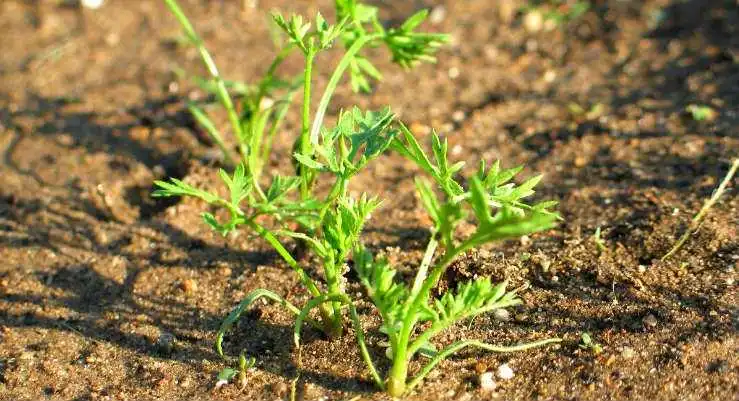Carrots are one of the most popular vegetables in the U.S. The crunchy orange veggies are a staple in many of our recipes, as well as a preferred snack for kids and adults alike. The USDA reports that the average American consumes around five pounds of carrots per year.
Considering carrots are so well-loved, it may come as no surprise that they are also one of the most widely-grown veggies in home vegetable gardens. This famous orange food is simple to grow and doing so is a great way to keep nutritious veggies on the kitchen table.
About Carrots
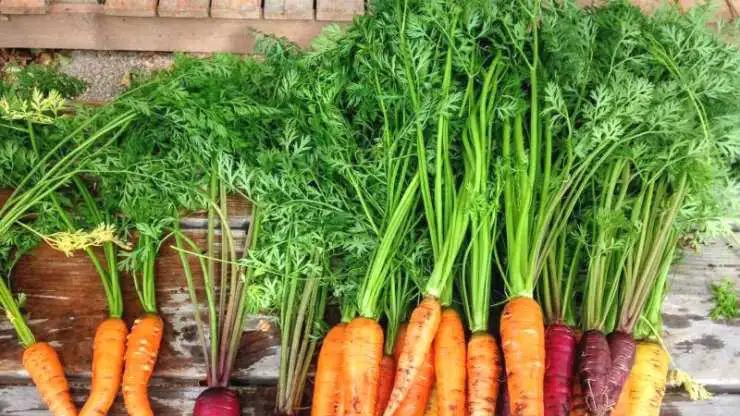
Carrots are a root vegetable native to Europe and Asia. The long, cylindrical shape and even bright orange hues that we associate with the carrot today resulted from centuries of selective breeding from the original root vegetable.
Carrots are an excellent source of vitamins A, K, and B6. Beta-carotene, which is the substance in carrots that gives them their color, is great for promoting healthy eyesight, skin, and the immune system.
A certain cartoon bunny rabbit certainly enjoyed snacking on the long, orange vegetables we all instantly recognize as the Carotene or Western Carrot, but not all of these popular root vegetables are orange.
The Eastern or Asiatic Carrot has a deep purple hue and is traditionally grown in Turkey, Egypt, and other parts of the middle east.
Although widely used in other parts of the world for millennia, the carrot that we know and love was not a household staple in the U.S. until after World War I, when American soldiers were exposed to the root vegetable overseas.
Carrots have been credited to sustaining many soldiers during the Great War who depended heavily on the nutrient-rich vegetable they had discovered.
During the second world war, a widely circulated rumor made civilians believe that carrot consumption could give them superhuman vision, including night vision that could help them win the war.
Of course, that was a stretch. But as people figured out how nutritious the carrot was (and they are great for promoting healthy vision!), as well as how tasty and versatile it was, the vegetable became a food staple in England during and after World War II.
As the carrot’s fame spread across Britain and Europe, it became even more well-loved across the pond in America. Today, carrots are a key ingredient for many savory and attractive dishes, and salads, as well as a popular raw snack option for all ages.
How To Grow Carrots?

Carrots are one of the easiest vegetables to grow at home. They do not produce sprawling vines, climb or take up much space.
Your own carrots can thrive in a backyard garden, in raised beds, or in a container garden.
They can even be grown on a window sill that receives plenty of direct sunlight!
Soil
They need loose, sandy soil that will allow them to develop into the right shape and, because they grow underground, they need at least 18 inches of soil.
Weather
Carrots are typically a cool weather crop, meaning they can be planted before the first expected frost date. To grow carrots from seed, sow them into the ground two to three weeks before the first frost. (Don’t know when the first expected frost date is? Check here)!
Because carrots are cool climate veggies, it is possible to have upwards of 9 months of harvesting in a mild climate if planting is timed right.
Sowing
Sow carrots approximately ½” deep in soil that is loose and free of rocks. Remember, carrots like loose, sandy soil.
If the native soil is naturally rocky, consider incorporating some potting soil into raised beds or containers.
Also, try mixing some sand into the dirt with a tiller or hoe. Soil that has a pH level between 5.8 and 6.5 is ideal for growing carrots.
Space the carrot seeds around 3 to 4 inches apart.
Planting them too close together will cause overcrowding and cause the vegetables to intertwine or just look misshapen.
If the plants are too close together, shortly after the carrot germination time (less than two weeks after planting) the plants will need to be thinned out.
How Long Do Carrots Take to Sprout?
The carrot’s first tiny sprouts are usually visible just after germination. Typically, it takes the tiny seeds between 10 and 12 days to germinate.
It may be difficult to tell whether the new plant is a carrot sprout or a weed.
The new sprouts need warm soil – between 60 and 65 degrees Fahrenheit to germinate properly.
Carrots reach full maturation and are ready to be harvested around 80 days after they are first planted.
What Do Carrot Sprouts Look Like?
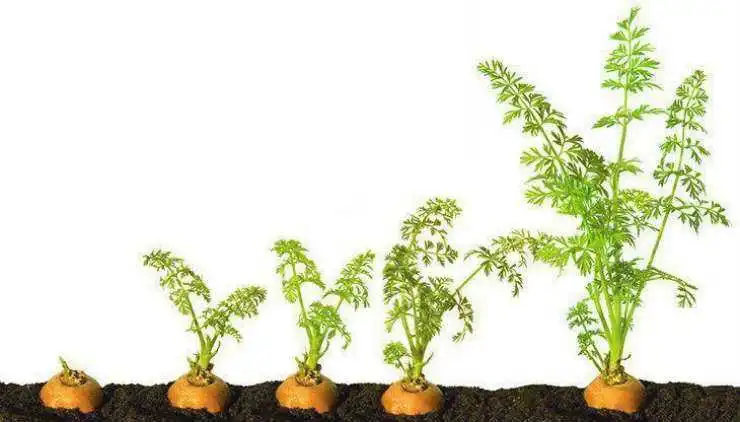
Let’s see how to identify carrot sprouts! If you have sown carrot seeds in a pot or raised bed, it should be relatively easy to distinguish your carrot seedlings. However, if you have cultivated the carrot seed in an area with weeds or grass, it may pose a slightly greater challenge to identify carrot sprouts.
After germination, some little foliage might start peeking through the top of the soil. Early on in the growing process, it can be difficult to tell if the carrots are sprouting or if weeds are just trying to steal the spotlight.
Carrots grow and reach full maturity within a span of 75 to 80 days after planting (2.5 to 3 months).
Shortly after germination, the first carrot sprout will appear above the soil. It may look like two tiny blades of grass in a “V” shape. These are called seed leaves.
During the upcoming weeks, the process of carrot growth will unfold as the carrot sprout continues to develop, while the carrot itself matures beneath the soil.
What Do Carrots Look Like When Ready to Harvest?
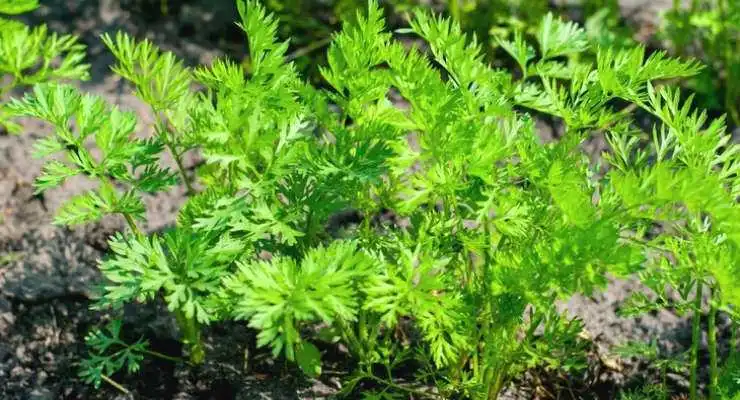
As the carrot develops underground, the foliage will grow, as well. The wide, top of the carrot – often called the “shoulders” – will be visible in the soil. Mature carrots will have shoulders that are roughly ¾” wide.
One of the carrot’s best features is that they can stay preserved underground for up to four weeks! Didn’t make it out to pick the carrot harvest this week? No worries – the carrot’s rough skin acts as a natural preservative and protects the vegetables from rotting.
The soil packed around the carrot essentially insulates the root vegetable, keeping it at an optimal temperature underground.
After carrots are harvested, gardeners may wonder, how long do carrots last?
Carrots have quite a long shelf life, unlike many vegetables, but similar to that of potatoes (another root vegetable). As long as they do not get too hot and remain at room temperature, carrots can last up to four weeks. In the refrigerator, they can last even longer – up to 5 weeks!
Why Are My Carrots Not Sprouting?
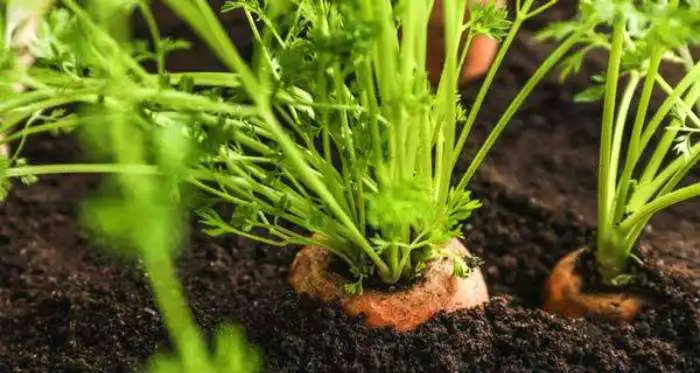
Carrots are a comparatively slow-growing vegetable, and while they are usually easy to grow, some new gardeners might have a crop that is not sprouting along the normal timeline. When encountering an unsuccessful crop, there are a few factors to examine.
First: Examine the Soil.
Carrots will not perform well in clay or loamy soil. They need light, loose soil. If the soil in the garden is particularly rocky or dense, consider adding some sand. Even better, try using a container garden, growing the carrots in a pot or similar container.
Also, consider building a raised bed. Turn the native soil underneath with a tiller or hoe and add potting mix and sand. Make sure that the raised beds or container gardens are deep enough to house maturing carrots. The soil needs to be 12 to 18 inches for the carrot to have enough room.
Second: Examine the Temperature.
Carrots are a cool climate crop, but that does not always mean a winter crop. Excessively cold or freezing temperatures will choke out carrot development. Carrots thrive in soil temperatures between 65 and 70 degrees Fahrenheit.
Conversely, temperatures can get too hot for carrots. Just like carrots cannot tolerate too much cold weather, nor can they tolerate excessive heat.
Because carrots can be planted up to three weeks before the first expected frost, some gardeners assume that they can be planted even earlier. But sowing carrot seeds too early can hinder or kill the crop. Just a few warm days in early spring does not mean that it is time to plant. Give the soil time to warm up to 70 degrees before planting.
Third: Check the Moisture.
Carrots do best when the soil has plenty of moisture without becoming soggy. Adding compost to the soil can help keep the garden well drained while retaining the appropriate amount of moisture.
How To Grow Carrot Plants From Carrot Tops
Carrot plants can experience regrowth from just a carrot top. To be clear, the root vegetable (actual carrots) cannot grow again from just a carrot top).
To grow the beloved carrot veggies, plant seeds in the soil and wait a few months. But a nice, leafy carrot plant can be cultivated for adornment as a small house plant.
A typical carrot from the garden of the grocery store will suffice, but a rounded baby carrot will not work. All that is needed to grow a carrot plant are the top of a carrot and some water.
Sprouting carrot tops to grow carrot plants can be a great activity to do with kids, especially if the kids enjoy having carrots as a snack. Simply have them save the tops of the carrots and let them grow a lovely plant that will be extra special for them.
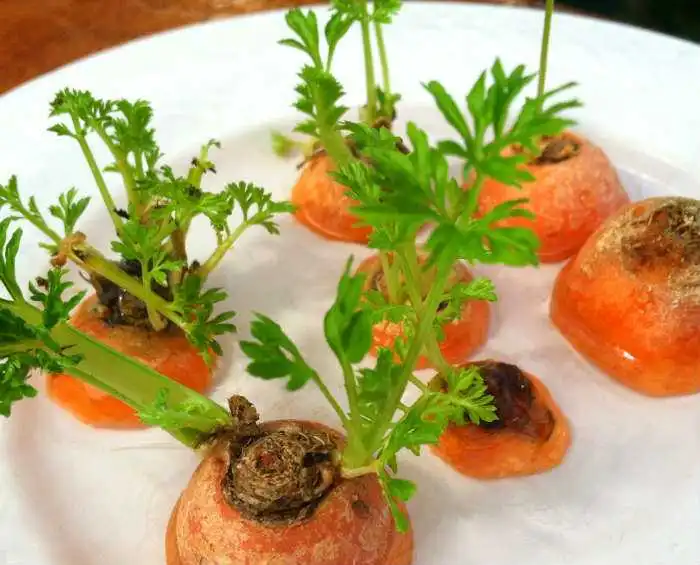
To grow more than one carrot plant, try employing either the newspaper or pie method (see below). It is much easier to sprout multiple carrot tops on a newspaper surface or on a pie plate than using multiple glass jars.
Carrot plants feature attractive, dainty foliage and bloom wispy, white flowers that are reminiscent of Queen Anne’s Lace in the spring. They are biennial plants, meaning they will last for two years once transplanted into soil.
They do not usually produce flowers for the first year but should display little white blooms in their second year.
There are a few different ways to grow carrot plants from carrot tops. Here are some of the most popular methods.
The Newspaper Method
To grow carrot plants from carrot tops, one way implements newspapers.
- Take several sheets of newspaper
- Wet the newspaper well. The paper should not be sopping wet or have standing water but should be completely moist.
- Cut the top of the carrot off from the rest of the vegetable, leaving ½” – ¾” of the shoulders.
- Place the carrot on top of the wet newspapers for several days.
The growth will be visible after a few days, as will root expansion. Be sure to keep the newspaper wet, adding drops of water as needed so that it does not dry out.
Once the roots have expanded, plant the small plant in a container to keep in a sunny part of the house, or transplant it outside.
The Water Method
To employ this method, use a jar or drinking glass (make sure that it is actually glass and not plastic).
- Place the carrot top on the bottom of the glass.
- Stabilize the carrot top by inserting toothpicks into the sides.
- Fill the glass with just enough water to reach the bottom edge of the carrot stump.
- Wait and watch for a few days.
- Make sure that the carrot receives plenty of sunlight. Try keeping it in a window sill or outside on a porch or patio.
- Add water as necessary if water evaporates (it will probably evaporate more quickly outside).
Before long, the carrots roots and foliage should start expanding. Once the roots have grown, it can be transplanted into soil.
The Pie Method
Another popular method is called the Pie Plate Method, or the Pie Method.
- Simply take an unused glass or ceramic pie dish
- Fill the bottom with one layer of marbles. Do not fill it with marbles all the way to the top. A shallow landing made from just one layer of marbles will suffice.
- Fill the pie pan with water that just reaches the top edge of the marbles. Do not completely submerge the marbles in water.
- Place carrot tops on the marbles.
- After a few days, check on the carrot tops.
Carrot leaves in the foliage should be growing and expanding and the roots should be expanding. Add water to the pie plate as necessary if water evaporates and be sure that it gets plenty of sunlight.
Preserving Carrots
Because many gardeners have such large carrot harvests and because they are also popular supermarket items, many people look for ways to best preserve their carrots. Fresh carrots can last for several weeks in the refrigerator or other cool environments. After that, they need to be cooked or frozen (or both!).
Fresh carrots can be frozen in freezer bags, but once they are thawed, they are better suited for cooking rather than snacking. Consider adding them to a recipe or preparing them as a dinner side dish.
Cooked carrots can also be frozen. Be sure to let them cool completely, then when they are at room temperature, place them in a freezer bag, remove as much of the air as possible, seal it, and toss it in the freezer to use at a future date.
Learn more about how long carrots last!
Is It Safe To Eat Sprouted Carrots?
Because carrots are a root vegetables and moisture can cause them to sprout, it is not uncommon for carrots to sprout roots if they have been lying on the counter for several days or even if they have been in the refrigerator for a few weeks.
People often wonder if carrots are safe to eat after they sprout. The short answer is, “Yes.” Roots do not make carrots dangerous to consume.
Sprouted carrots might not be too tasty, though. Growing roots is a sign that the vegetable is aging. Also, much of the vitamins that had been stored in the carrot are now being used up in the roots.
Essentially, the carrot is using up all its energy in sprouting and will thus be a little rubbery or soft and may taste funny.
If a carrot is emitting an odor, the rotting process is underway and should be discarded. Never consume a carrot that does not smell fresh. Carrots are also characterized by their crispness.
We recommend “The Snap Test.”
If a carrot does not snap into two pieces easily when it is bent, then it is no longer fresh and either needs to be cooked or eaten right away or discarded.
If the carrot has any white spots, called “white blush”, it should probably just be thrown away. Remember, a good rule of thumb when it comes to any type of food is “When in doubt, don’t.” If it does not look or smell fresh, it is best not to chance it.
Conclusion
Carrots are a favorite veggie in the U.S. for good reason. They are chock full of vitamins, versatile, and easy to grow. But they can serve as more than just nutritional staples.
Carrots can also provide great learning opportunities for children. Try letting kids help plant, wash and harvest one of their favorite snacks. Then, let them use the carrot tops to grow blooming carrot plants.
Reference some of our handy methods for sprouting carrot tops and transplanting carrot plants and enjoy a fun, warm weather activity with the family!
